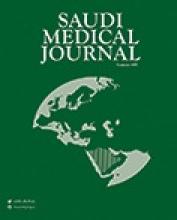REVIEW ARTICLE
Roles of nucleolin. Focus on cancer and anti-cancer therapy
Chen & Xu describe how nucleolin act functions in cancer development and describe nucleolin-dependent anti-cancer therapies. They conclude that the level and localization of nucleolin is aberrant and contributes to the progression of cancer, including carcinogenesis, proliferation, angiogenesis, and metastasis. Thus, nucleolin is a promising target for anti-cancer therapy. Although some achievements have been gained, there are many challenges.
The effects of nucleolin in cancers
see page 1312
ORIGINAL ARTICLES
Open globe eye injury characteristics and prognostic factors in Jazan, Saudi Arabia
Makhrash & Gosadi evaluate characteristics and prognostic factors of open globe injuries (OGI) presented to King Fahad Specialist Hospital in the Jazan region, Saudi Arabia. Number of included cases was 120. Most frequently reported causes of injury were blunt trauma (20%) and shattered glass (18.3%). Approximately half of the cases were reported to have iris injuries or hyphema. Most cases suffered penetration (37.5%) of the eye globe. They conclude that Zone I injury appears to have a better prognostic effect on visual acuity where injuries related to Zone III were associated with worse prognostic outcomes.
Multivariate analysis of the prognostic factors associated with improvements in the visual acuity of 120 open globe injury cases
see page 1328
Gastroesophageal stenting for the management of post sleeve gastrectomy leak. A single institution experience
Guzaiz et al found that gastroesophageal stenting as a primary measure after diagnosis of early post sleeve gastrectomy leak appears to offer a safe and effective alternative option in obviating repeat surgical interventions. Minimally invasive interventions may still be required for the management of persistent leak. Stent placement was technically successful in all patients. Stent migration occurred in 6 patients (50%). There is a tendency for stent migration with shorter stent length. The mean duration of stenting was 60.5 days (14-137 days). All patients underwent stent removal and resumed oral intake with no recurrence of leak at a mean follow up time of 190 days (14-410 days).
see page 1334
CASE REPORT
Excision of oral pyogenic granuloma in a diabetic patient with 940nm diode laser
Al-Mohaya & Al-Malik present a case of gingival Pyogenic granuloma (PG) in a 51-year-old uncontrolled diabetic woman. The lesion was excised successfully with a 940nm diode laser as a conservative and non-stressful procedure that resulted in a bloodless surgical and post-surgical course with rapid healing, minimal pain, swelling, and scarring. The 940nm Diode laser offers a new efficient noninvasive tool for excising oral soft tissue lesions, especially in medically compromised patients.
A) Large gingival exophytic ulcerated and lobulated mass covering the buccal surfaces of the teeth and extending into the vestibule. B) Reflecting the mass to examine the point of origin.
see page 1395
- Copyright: © Saudi Medical Journal
This is an open-access article distributed under the terms of the Creative Commons Attribution-Noncommercial-Share Alike 3.0 Unported, which permits unrestricted use, distribution, and reproduction in any medium, provided the original work is properly cited.










